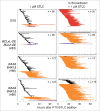Paclitaxel-induced aberrant mitosis and mitotic slippage efficiently lead to proliferative death irrespective of canonical apoptosis and p53
- PMID: 27764550
- PMCID: PMC5176135
- DOI: 10.1080/15384101.2016.1242537
Paclitaxel-induced aberrant mitosis and mitotic slippage efficiently lead to proliferative death irrespective of canonical apoptosis and p53
Abstract
Spindle poisons elicit various cellular responses following metaphase arrest, but how they relate to long-term clonogenicity has remained unclear. We prepared several HeLa lines in which the canonical apoptosis pathway was attenuated, and compared their acute responses to paclitaxel, as well as long-term fate, with the parental line. Three-nanomolar paclitaxel induced brief metaphase arrest (<5 h) often followed by aberrant mitosis, and about 90% of the cells of each line had lost their clonogenicity after 48 h of the treatment. A combination of the same concentration of paclitaxel with the kinesin-5 inhibitor, S-trityl-L-cysteine (STLC), at 1 µM led to much longer arrest (∼20 h) and predominance of subsequent line-specific responses: mitochondrial outer membrane permeabilization (MOMP) in the apoptosis-prone line, or mitotic slippage without obvious MOMP in the apoptosis-reluctant lines. In spite of this, combination with STLC did not lead to a marked difference in clonogenicity between the apoptosis-prone and -reluctant lines, and intriguingly resulted in slightly better clonogenicity than that of cells treated with 3 nM paclitaxel alone. This indicates that changes in the short-term response within 3 possible scenarios - acute MOMP, mitotic slippage or aberrant mitosis - has only a weak impact on clonogenicity. Our results suggest that once cells have committed to slippage or aberrant mitosis they eventually undergo proliferative death irrespective of canonical apoptosis or p53 function. Consistent with this, cells with irregular DNA contents originating from mitotic slippage or aberrant mitosis were mostly eliminated from the population within several rounds of division after the drug treatment.
Keywords: Aberrant mitosis; apoptosis; metaphase arrest; mitotic catastrophe; mitotic slippage; paclitaxel; spindle assembly checkpoint; spindle poison.
Figures






Similar articles
-
Effects of chemical manipulation of mitotic arrest and slippage on cancer cell survival and proliferation.Cell Cycle. 2009 Sep 15;8(18):3025-38. Epub 2009 Sep 25. Cell Cycle. 2009. PMID: 19713760
-
Proteome analysis of apoptosis signaling by S-trityl-L-cysteine, a potent reversible inhibitor of human mitotic kinesin Eg5.Proteomics. 2008 Jan;8(2):289-300. doi: 10.1002/pmic.200700534. Proteomics. 2008. PMID: 18186019
-
Post-slippage multinucleation renders cytotoxic variation in anti-mitotic drugs that target the microtubules or mitotic spindle.Cell Cycle. 2014;13(11):1756-64. doi: 10.4161/cc.28672. Epub 2014 Apr 2. Cell Cycle. 2014. PMID: 24694730 Free PMC article.
-
Using Budding Yeast to Identify Molecules That Block Cancer Cell 'Mitotic Slippage' Only in the Presence of Mitotic Poisons.Int J Mol Sci. 2021 Jul 26;22(15):7985. doi: 10.3390/ijms22157985. Int J Mol Sci. 2021. PMID: 34360748 Free PMC article. Review.
-
The role of p53 in the response to mitotic spindle damage.Pathol Biol (Paris). 2000 Apr;48(3):246-54. Pathol Biol (Paris). 2000. PMID: 10858957 Review.
Cited by
-
Stilbene Compounds Inhibit Tumor Growth by the Induction of Cellular Senescence and the Inhibition of Telomerase Activity.Int J Mol Sci. 2019 Jun 2;20(11):2716. doi: 10.3390/ijms20112716. Int J Mol Sci. 2019. PMID: 31159515 Free PMC article. Review.
-
Bcl-xL activity influences outcome of the mitotic arrest.Front Pharmacol. 2022 Sep 15;13:933112. doi: 10.3389/fphar.2022.933112. eCollection 2022. Front Pharmacol. 2022. PMID: 36188556 Free PMC article.
-
Tinker, Tailor, Tumour Suppressor: The Many Functions of PRP4K.Front Genet. 2022 Feb 24;13:839963. doi: 10.3389/fgene.2022.839963. eCollection 2022. Front Genet. 2022. PMID: 35281802 Free PMC article. Review.
-
Alginate coated mesoporous silica nanoparticles as oral delivery carrier of curcumin and quercetin to colon cancer: preparation, optimization, characterization, and anticancer activity.Drug Deliv Transl Res. 2025 Jan 12. doi: 10.1007/s13346-024-01777-6. Online ahead of print. Drug Deliv Transl Res. 2025. PMID: 39800814
-
BioID-based proteomic analysis of the Bid interactome identifies novel proteins involved in cell-cycle-dependent apoptotic priming.Cell Death Dis. 2020 Oct 16;11(10):872. doi: 10.1038/s41419-020-03091-8. Cell Death Dis. 2020. PMID: 33067418 Free PMC article.
References
-
- Gascoigne KE, Taylor SS. Cancer cells display profound intra- and interline variation following prolonged exposure to antimitotic drugs. Cancer Cell 2008; 14:111-22; PMID:18656424; http://dx.doi.org/10.1016/j.ccr.2008.07.002 - DOI - PubMed
-
- Blagosklonny MV. Mitotic arrest and cell fate: why and how mitotic inhibition of transcription drives mutually exclusive events. Cell Cycle 2007; 6:70-4; PMID:17245109; http://dx.doi.org/10.4161/cc.6.1.3682 - DOI - PubMed
-
- Wan L, Tan M, Yang J, Inuzuka H, Dai X, Wu T, Liu J, Shaik S, Chen G, Deng J, et al.. APC(Cdc20) suppresses apoptosis through targeting bim for ubiquitination and destruction. Dev Cell 2014; 29:377-91; PMID:24871945; http://dx.doi.org/10.1016/j.devcel.2014.04.022 - DOI - PMC - PubMed
-
- Díaz-Martínez LA, Karamysheva ZN, Warrington R, Li B, Wei S, Xie X-J, Roth MG, Yu H. Genome-wide siRNA screen reveals coupling between mitotic apoptosis and adaptation. EMBO J 2014; 33:1960-76; PMID:25024437; http://dx.doi.org/10.15252/embj.201487826 - DOI - PMC - PubMed
-
- Wang P, Lindsay J, Owens TW, Mularczyk EJ, Warwood S, Foster F, Streuli CH, Brennan K, Gilmore AP. Phosphorylation of the proapoptotic BH3-only protein bid primes mitochondria for apoptosis during mitotic arrest. Cell Reports 2014; 7:661-71; PMID:24767991; http://dx.doi.org/10.1016/j.celrep.2014.03.050 - DOI - PMC - PubMed
MeSH terms
Substances
LinkOut - more resources
Full Text Sources
Other Literature Sources
Research Materials
Miscellaneous
